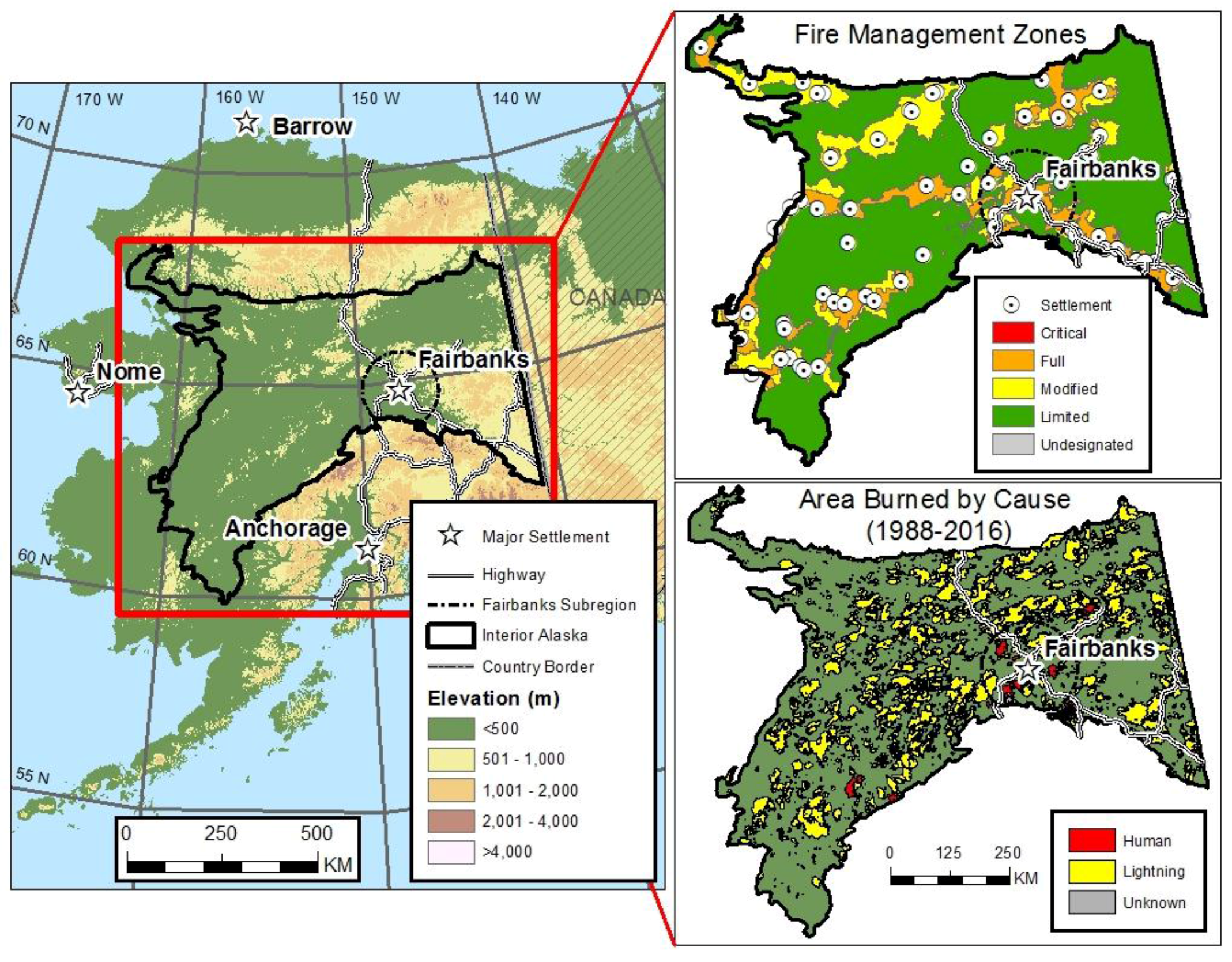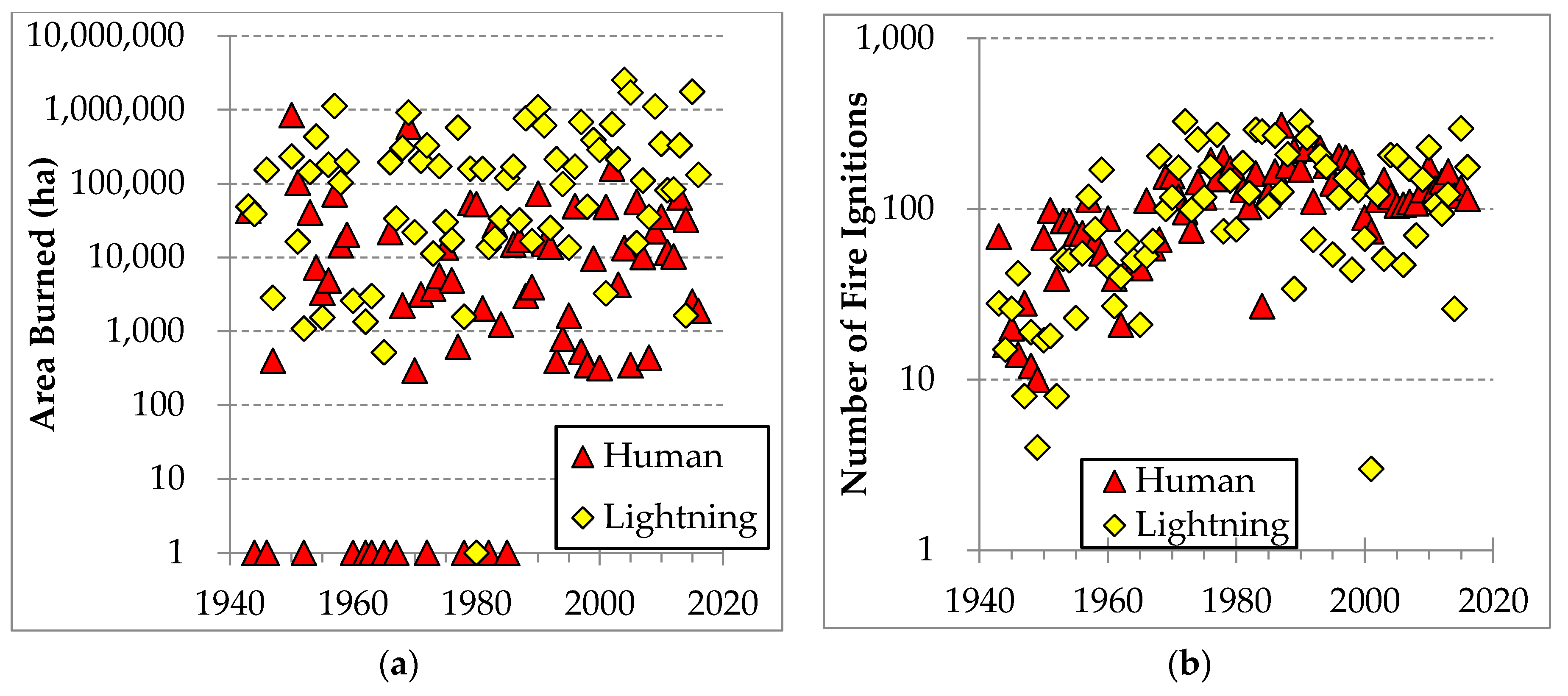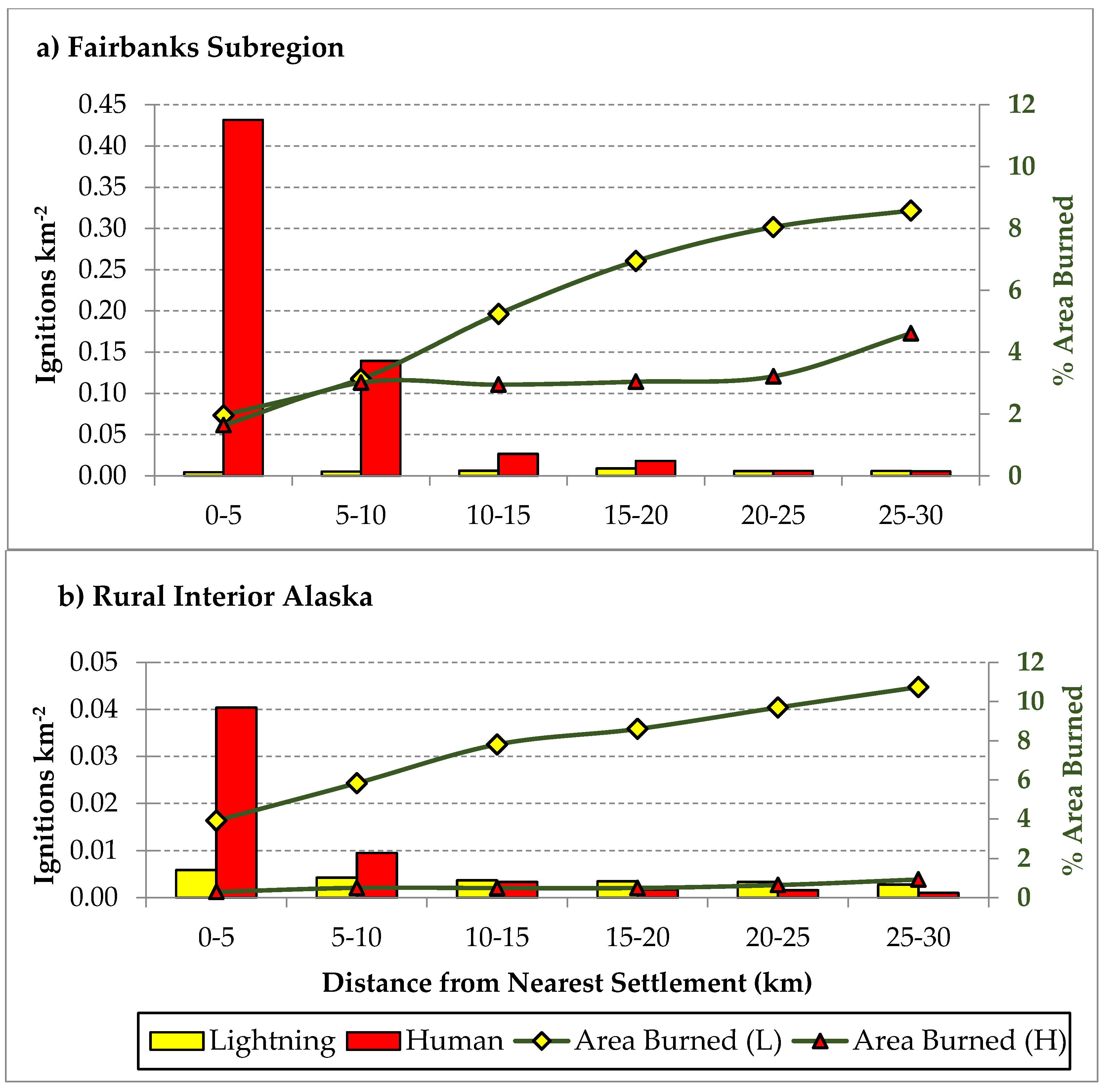Differences in Human versus Lightning Fires between Urban and Rural Areas of the Boreal Forest in Interior Alaska
Abstract
:1. Introduction
2. Materials and Methods
2.1. Study Area
2.2. Geospatial Datasets
2.3. Geospatial and Quantitative Analysis
2.3.1. Differences in Temporal Trends between Urban and Rural Interior Alaska
2.3.2. Differences in the Influences of Human Proximity between Urban and Rural Interior Alaska
2.3.3. Differences in Fire Seasonality and Duration
3. Results
3.1. Differences in Temporal Trends between Urban and Rural Interior Alaska
3.2. Differences in the Influences of Human Proximity between Urban and Rural Interior Alaska
3.3. Differences in Fire Seasonality and Duratio
4. Discussion
4.1. Differences in Temporal Trends between Urban and Rural Interior Alaska
4.2. Differences in the Influences of Human Proximity between Urban and Rural Interior Alaska
4.3. Differences in Fire Seasonality and Duration
5. Conclusions
Acknowledgments
Author Contributions
Conflicts of Interest
References
- Scharlemann, J.P.; Tanner, E.V.; Hiederer, R.; Kapos, V. Global soil carbon: Understanding and managing the largest terrestrial carbon pool. Carbon Manag. 2014, 5, 81–91. [Google Scholar] [CrossRef]
- Gauthier, S.; Bernier, P.; Kuuluvainen, T.; Shvidenko, A.; Schepaschenko, D. Boreal forest health and global change. Science 2015, 349, 819–822. [Google Scholar] [CrossRef] [PubMed]
- Gillett, N.P.; Weaver, A.J.; Zwiers, E.W.; Flannigan, M.D. Detecting the effect of climate change on canadian forest fires. Geophys. Res. Lett. 2004, 31. [Google Scholar] [CrossRef]
- Soja, A.J.; Tchebakova, N.M.; French, N.H.F.; Flannigan, M.D.; Shugart, H.H.; Stocks, B.J.; Sukhinin, A.I.; Parfenova, E.I.; Chapin, F.S., III; Stackhouse, P.W., Jr. Climate-induced boreal forest change: Predictions versus current observations. Glob. Planet. Chang. 2007, 56, 274–296. [Google Scholar] [CrossRef]
- Kasischke, E.S.; Verbyla, D.L.; Rupp, T.S.; McGuire, A.D.; Murphy, K.A.; Jandt, R.; Barnes, J.L.; Hoy, E.E.; Duffy, P.A.; Calef, M.P.; et al. Alaska’s changing fire regime—Implications for the vulnerability of its boreal forests. Can. J. For. Res. 2010, 40, 1313–1324. [Google Scholar] [CrossRef]
- Kasischke, E.S.; Turetsky, M.R. Recent changes in the fire regime across the north american boreal region—Spatial and temporal patterns of burning across canada and alaska. Geophys. Res. Lett. 2006, 33, 1–5. [Google Scholar] [CrossRef]
- Ponomarev, E.I.; Kharuk, V.I.; Ranson, K.J. Wildfires dynamics in siberian larch forests. Forests 2016, 7, 125. [Google Scholar] [CrossRef]
- Kelly, R.; Genet, H.; McGuire, A.D.; Hu, F.S. Palaeodata-informed modelling of large carbon losses from recent burning of boreal forests. Nat. Clim. Chang. 2016, 6, 79–82. [Google Scholar] [CrossRef]
- Turetsky, M.R.; Kane, E.S.; Harden, J.W.; Ottmar, R.D.; Manies, K.L.; Hoy, E.; Kasischke, E.S. Recent acceleration of biomass burning and carbon losses in alaskan forests and peatlands. Nat. Geosci. 2011, 4, 27–31. [Google Scholar] [CrossRef]
- Amiro, B.D.; Todd, J.B.; Wotton, B.M.; Logan, K.A.; Flannigan, M.D.; Stocks, B.J.; Mason, J.A.; Martell, D.L.; Hirsch, A. Direct carbon emissions from canadian forest firest, 1959–1999. Can. J. For. Res. 2005, 31, 512–525. [Google Scholar] [CrossRef]
- Balshi, M.S.; McGuire, A.D.; Duffy, P.; Flannigan, M.D.; Walsh, J.; Melillo, J.M. Assessing the response of area burned to changing climate in western boreal north america using a multivariate adaptive regression splines (mars) approach. Glob. Chang. Biol. 2009, 15, 578–600. [Google Scholar] [CrossRef]
- Amiro, B.D.; Cantin, A.; Flannigan, M.D.; De Groot, W. Future emissions from canadian boreal forest fires. Can. J. For. Res. 2009, 39, 383–395. [Google Scholar] [CrossRef]
- Balshi, M.S.; McGuire, A.D.; Duffy, P.; Flannigan, M.; Kicklighter, D.W.; Melillo, J. Vulnerability of carbon storage in north american boreal forests to wildfires during the 21st century. Glob. Chang. Biol. 2009, 15, 1491–1510. [Google Scholar] [CrossRef]
- Young, A.M.; Higuera, P.E.; Duffy, P.A.; Hu, F.S. Climatic thresholds shape northern high-latitude fire regimes and imply vulnerability to future climate change. Ecography 2017, 40, 606–617. [Google Scholar] [CrossRef]
- Serreze, M.C.; Barry, R.G. Processes and impacts of arctic amplification: A research synthesis. Glob. Planet. Chang. 2011, 77, 85–96. [Google Scholar] [CrossRef]
- Mann, D.H.; Rupp, T.S.; Olson, M.A.; Duffy, P.A. Is alaska’s boreal forest now crossing a major ecological threshold? Arct. Antarct. Alp. Res. 2012, 44, 319–331. [Google Scholar] [CrossRef]
- Héon, J.; Arsenault, D.; Parisien, M.-A. Resistance of the boreal forest to high burn rates. Proc. Natl. Acad. Sci. USA 2014, 111, 13888–13893. [Google Scholar] [CrossRef] [PubMed]
- Wolken, J.M.; Hollingsworth, T.N.; Rupp, T.S.; Chapin III, F.S.; Trainor, S.F.; Barrett, T.M.; Sullivan, P.F.; McGuire, A.D.; Euskirchen, S.E.; Hennon, P.E.; et al. Evidence and implications of recent and projected climate change in alaska’s forest ecosystems. Ecosphere 2011, 2, 1–35. [Google Scholar] [CrossRef]
- Pastick, N.J.; Duffy, P.; Genet, H.; Rupp, T.S.; Wylie, B.K.; Johnson, K.D.; Jorgenson, M.T.; Bliss, N.; McGuire, A.D.; Jafarov, E.E.; et al. Historical and projected trends in landscape drivers affecting carbon dynamics in alaska. Ecol. Appl. 2017, 27, 1383–1402. [Google Scholar] [CrossRef] [PubMed]
- Aldersley, A.; Murray, S.J.; Cornell, S.E. Global and regional analysis of climate and human drivers of wildfire. Sci. Total Environ. 2011, 409, 3472–3481. [Google Scholar] [CrossRef] [PubMed]
- Abatzoglou, J.T.; Kolden, C.A. Relative importance of weather and climate on wildfire growth in interior alaska. Int. J. Wildland Fire 2011, 20, 479–486. [Google Scholar] [CrossRef]
- Kelly, R.; Chipman, M.L.; Higuera, P.E.; Stefanova, I.; Brubaker, L.B.; Hu, F.S. Recent burning of boreal forests exceeds fire regime limits of the past 10,000 years. Proc. Natl. Acad. Sci. USA 2013, 110, 13055–13060. [Google Scholar] [CrossRef] [PubMed]
- Krawchuk, M.A.; Cumming, S.G.; Wein, R.W. Biotic and abiotic regulation of lightning fire initiation in the mixedwood boreal forest. Ecology 2006, 87, 458–468. [Google Scholar] [CrossRef] [PubMed]
- Rupp, T.S.; Starfield, A.M.; Chapin, F.S.I.; Duffy, P. Modeling the impact of black spruce on the fire regime of alaskan boreal forest. Clim. Chang. 2002, 55, 213–233. [Google Scholar] [CrossRef]
- Butsic, V.; Kelly, M.; Moritz, M.A. Land use and wildfire: A review of local interactions and teleconnections. Land 2015, 4, 140–156. [Google Scholar] [CrossRef]
- DeWilde, L.; Chapin, F.S.I. Human impacts on the fire regime of interior alaska: Interactions among fuels, ignition sources, and fire suppression. Ecosystems 2006, 9, 1342–1353. [Google Scholar] [CrossRef]
- Cumming, S.G. Effective fire suppression in boreal forests. Can. J. Forest Res. 2005, 35, 772–786. [Google Scholar] [CrossRef]
- Ward, P.C.; Tithecott, A.G.; Wotton, B.M. Reply—A re-examination of the effects of fire suppression in the boreal forest. Can. J. Forest Res. 2001, 31, 1467–1480. [Google Scholar]
- Veraverbeke, S.; Rogers, B.M.; Goulden, M.L.; Jandt, R.R.; Miller, C.E.; Wiggins, E.B.; Randerson, J.T. Lightning as a major driver of recent large fire years in north american boreal forests. Nat. Clim. Chang. 2017, 7, 529–534. [Google Scholar] [CrossRef]
- Kovacs, K.; Ranson, K.J.; Sun, G.; Kharuk, V.I. The relationship of the terra modis fire product and anthropogenic features in the central siberian landscape. Earth Interact. 2004, 8, 1–25. [Google Scholar] [CrossRef]
- Calef, M.P.; McGuire, A.D.; Chapin III, F.S. Human influences on wildfire in alaska from 1988 through 2005: An analysis of the spatial patterns of human impacts. Earth Interact. 2008, 12, 1–17. [Google Scholar] [CrossRef]
- Wu, Z.; He, H.S.; Yang, J.; Liu, Z.; Liang, Y. Relative effects of climatic and local factors on fire occurence in boreal forest landscapes of northeastern china. Sci. Total Environ. 2014, 493, 472–480. [Google Scholar] [CrossRef] [PubMed]
- Krawchuk, M.A.; Moritz, M.A.; Parisien, M.-A.; Van Dorn, J.; Hayhoe, K. Global pyrogeography: The current and future distribution of wildfire. PLoS ONE 2009, 4, e5102. [Google Scholar] [CrossRef] [PubMed]
- Syphard, A.; Radeloff, V.C.; Keeley, J.E.; Hawbaker, T.J.; Clayton, M.K.; Stewart, S.I.; Hammer, R.B. Human influence on california fire regimes. Ecol. Appl. 2007, 17, 1388–1402. [Google Scholar] [CrossRef] [PubMed]
- Hantson, S.; Pueyo, S.; Chuvieco, E. Global fire size distribution is driven by human impact and climate. Global Ecol. Biogeogr. 2015, 24, 77–86. [Google Scholar] [CrossRef]
- Lutz, H.J. Aboriginal Man and White Man as Historical Causes of Fires in the Boreal Forest, with Particular Reference to Alaska; School of Forestry, Yale University: New Haven, CT, USA, 1959; p. 49. [Google Scholar]
- Natcher, D.C.; Calef, M.P.; Huntington, O.; Trainor, S.F.; Huntington, H.P.; DeWilde, L.; Rupp, T.S.; Chapin, F.S., III. Factors contributing to the cultural and spatial variability of landscape burning by native peoples of interior alaska. Ecol. Soc. 2007, 12, 7. [Google Scholar] [CrossRef]
- Bourgeau-Chavez, L.L.; Alexander, M.E.; Stocks, B.J.; Kasischke, E.S. Distribution of forest ecosystems and the role of fire in the north american boreal region. In Fire, Climate Change, and Carbon Cycling in the Boreal Forest; Kasischke, E.S., Stocks, B.J., Eds.; Springer: New York, NY, USA, 2000; Volume 138, pp. 111–131. [Google Scholar]
- Wendler, G.; Shulski, M. A century of climate change for fairbanks, alaska. Arctic 2009, 62, 295–300. [Google Scholar] [CrossRef]
- Barber, V.G.; Juday, G.P.; Finney, B.P.; Wilmking, M. Reconstruction of summer temperatures in interior alaska from tree-ring proxies: Evidence for changing climate regimes. Clim. Chang. 2004, 63, 91–120. [Google Scholar] [CrossRef]
- Barber, V.A.; Juday, G.P.; Finney, B.P. Reduced growth of alaskan white spruce in the twentieth century from temperature-induced drought stress. Nature 2000, 405, 668–673. [Google Scholar] [CrossRef] [PubMed]
- Lynch, J.A.; Clark, J.S.; Bigelow, N.H.; Edwards, M.E.; Finney, B.P. Geographic and temporal variations in fire history in boreal ecosystems of alaska. J. Geophys. Res. 2003, 108, 1–17. [Google Scholar] [CrossRef]
- Henry, D.M. Fire Occurence Using 500 mb Map Correlation; NWS AR-21; NOAA Technical Memorandum: Anchorage, AK, USA, 1978.
- DeWilde, L. Human Impacts on the Fire Regime of Interior Alaska. Master’s Thesis, University of Alaska, Fairbanks, AK, USA, 2003. [Google Scholar]
- Wendler, G.; Conner, J.; Moore, B.; Shulski, M.; Stuefer, M. Climatology of alaskan wildfires with special emphasis on the extreme year of 2004. Theor. Appl. Climatol. 2011, 104, 459–472. [Google Scholar] [CrossRef]
- Guo, F.; Innes, J.L.; Wang, G.; Ma, X.; Sun, L.; Hu, H.; Su, Z. Historic distribution and driving factors of human-caused fires in the chinese boreal forest between 1972 and 2005. J. Plant Ecol. 2015, 8, 480–490. [Google Scholar] [CrossRef]
- Gaglioti, B.V.; Mann, D.H.; Jones, B.M.; Wooller, M.J.; Finney, B.P. High-resolution records detect human-caused changes to the boreal forest wildfire regime in interior alaska. Holocene 2016, 26, 1064–1074. [Google Scholar] [CrossRef]
- Chapin, F.S.; Rupp, T.S.; Starfield, A.M.; DeWilde, L.; Zavaleta, E.S.; Fresco, N.; Henkelman, J.; McGuire, A.D. Planning for resilience: Modeling change in human-fire interactions in the alaskan boreal forest. Front. Ecol. Environ. 2003, 1, 255–261. [Google Scholar] [CrossRef]
- Calef, M.P.; Varvak, A.; McGuire, A.D.; Chapin III, F.S.; Reinhold, K.B. Recent changes in annual area burned in interior alaska: The impact of fire management. Earth Interact. 2015, 19, 1–17. [Google Scholar] [CrossRef]
- Gallant, A.L.; Binnian, E.F.; Omernik, J.M.; Shasby, M.B. Ecoregions of Alaska; USGS Professional Paper 1567; USGS Publications Warehouse: Oklahoma City, OK, USA, 1995; p. 73.
- Alaska Fire Service. Available online: https://afsmaps.blm.gov/ (accessed on 1 August 2017).
- Kasischke, E.S.; Williams, D.; Barry, D. Analysis of patterns of large fires in the boreal forest region of alaska. Int. J. Wildland Fire 2002, 11, 131–144. [Google Scholar] [CrossRef]
- Kasischke, E.S.; Loboda, T.; Giglio, L.; French, N.H.F.; Hoy, E.E.; de Jong, B.; Riano, D. Quantifying burned area for north american forests: Implications for direct reduction of carbon stocks. J. Geophys. Res. Atmos. 2011, 116, 1–17. [Google Scholar] [CrossRef]
- Mantua, N.J.; Hare, S.R.; Zhang, Y.; Wallace, J.M.; Francis, R.C. A pacific interdecadal climate oscillation with impacts on salmon production. Bull. Am. Meteorol. Soc. 1997, 78, 1069–1079. [Google Scholar] [CrossRef]
- Duffy, P.; Walsh, J.E.; Mann, D.H.; Graham, J.M.; Rupp, T.S. Impacts of large-scale atmospheric-ocean variability on alaskan fire season severity. Ecol. Appl. 2005, 15, 1317–1330. [Google Scholar] [CrossRef]
- Todd, S.K.; Jewkes, H.A. Wildland Fire in Alaska: A History of Organized Fire Suppression and Management in the Last Frontier; Agricultural and Forestry Experiment Station Bulletin No. 114; University of Alaska Fairbanks: Fairbanks, AK, USA, 2006; p. 63. [Google Scholar]
- Siegel, S.; Tukey, J.W. A nonparametric sum of ranks procedure for relative spread in unpaired samples. J. Am. Stat. Assoc. 1960, 55, 429–445. [Google Scholar] [CrossRef]
- Karl, T.R.; Arguez, A.; Huang, B.; Lawrimore, J.H.; McMahon, J.R.; Menne, M.J.; Peterson, T.C.; Vose, R.S.; Zhang, H.-M. Possible artifacts of data biases in the recent global surface warming hiatus. Science 2015, 348, 1469–1472. [Google Scholar] [CrossRef] [PubMed]
- Gonzalez-Olabarria, J.R.; Brotons, L.; Gritten, D.; Tudela, A.; Teres, J.A. Identifying location and causality of fire ignition hotspots in a mediterranean region. Int. J. Wildland Fire 2012, 21, 905–914. [Google Scholar] [CrossRef]
- Sanderson, E.W.; Jaiteh, M.; Levy, M.A.; Redford, K.H.; Wannebo, A.V.; Woolmer, G. The human footprint and the last of the wild. BioScience 2002, 52, 891–904. [Google Scholar] [CrossRef]
- Dissing, D.; Verbyla, D.L. Spatial patterns of lightning strikes in interior alaska and their relations to elevation and vegetation. Can. J. Forest Res. 2003, 33, 770–782. [Google Scholar] [CrossRef]
- Kimball, J.S.; McDonald, K.C.; Zhao, M. Spring thaw and its effect on terrestrial vegetation productivity in the western arctic observed from satellite microwave and optical remote sensing. Earth Interact. 2006, 10, 1–22. [Google Scholar] [CrossRef]





| (a) Fairbanks | |||||||||||
| Odds Ratio of Fire Occurrence | N | Area Burned Trends | |||||||||
| 1943–2016 | b | SE | z | Odds Ratio | b | SE | t | Yearly Change | |||
| Both | 0.074 | 0.021 | 3.55 | 1.077 | *** | 55 | 0.006 | 0.006 | 0.975 | 1.3% | |
| Human | 0.052 | 0.015 | 3.51 | 1.054 | *** | 41 | −0.013 | 0.007 | −1.891 | −3.0% | |
| Lightning | 0.066 | 0.017 | 3.91 | 1.068 | *** | 43 | −0.003 | 0.007 | −0.406 | −0.7% | |
| 1988–2016 | |||||||||||
| Both | 0.842 | 0.857 | 0.98 | 2.321 | 28 | 0.019 | 0.020 | 0.957 | 4.5% | ||
| Both 1 | NA 1 | 29 | 0.097 | 10.2% | |||||||
| Human | 0.189 | 0.094 | 2.00 | 1.208 | * | 24 | 0.007 | 0.025 | 0.274 | 1.6% | |
| Human | NA 1 | 29 | 0.065 | 0.031 | 2.123 | 16.1% | * | ||||
| Lightning | 0.129 | 0.115 | 1.12 | 1.138 | 27 | 0.000 | 0.023 | −0.001 | 0.0% | ||
| Lightning | NA 1 | 29 | 0.024 | 0.029 | 0.821 | 5.7% | |||||
| (b) Rural Interior Alaska | |||||||||||
| Odds Ratio of Fire Occurrence | N | Area Burned Trend | |||||||||
| 1943–2016 | b | SE | z | Odds Ratio | b | SE | t | Change | |||
| Both | NA 2 | 69 | 0.011 | 0.005 | 2.273 | 2.6% | * | ||||
| Human | 0.038 | 0.015 | 2.62 | 1.039 | ** | 49 | −0.008 | 0.006 | −1.286 | −1.7% | |
| Lightning | NA 3 | 68 | 0.012 | 0.005 | 2.334 | 2.9% | * | ||||
| 1988–2016 | |||||||||||
| Both | NA 2 | 29 | 0.003 | 0.016 | 0.160 | 0.7% | |||||
| Human | 0.056 | 0.093 | 0.60 | 1.057 | 27 | 0.009 | 0.019 | 0.442 | 2.0% | ||
| Human | NA 1 | 29 | 0.021 | 0.028 | 0.752 | 4.9% | |||||
| Lightning | NA 2 | 29 | −0.004 | 0.019 | −0.204 | −0.9% | |||||
| Fairbanks | Rural Int. AK | |||||||
|---|---|---|---|---|---|---|---|---|
| 1943–2016 | b | SE | t | Yearly Change | b | SE | t | Yearly Change |
| Both | 0.011 | 0.001 | 4.468 | 2.5% *** | 0.009 | 0.002 | 5.464 | 2.1% *** |
| Human | 0.011 | 0.002 | 6.897 | 2.5% *** | 0.009 | 0.002 | 5.368 | 2.1% *** |
| Lightning | 0.011 | 0.002 | 4.387 | 2.5% *** | 0.010 | 0.002 | 4.472 | 2.3% *** |
| 1988–2016 | ||||||||
| Both | −0.010 | 0.003 | −3.457 | −2.3% ** | <−0.001 | 0.006 | −0.029 | −0.0% |
| Human | −0.011 | 0.003 | −4.108 | −2.6% *** | <0.001 | 0.003 | −0.010 | −0.0% |
| Human Full FMZ | −0.014 | 0.003 | −4.799 | −3.2% *** | −0.004 | 0.004 | −1.045 | −1.0% |
| Lightning | −0.004 | 0.010 | −0.406 | −1.0% | <−0.001 | 0.009 | −0.038 | −0.1% |
| Region | Cause | Yearly Change | b | SE | z |
|---|---|---|---|---|---|
| Interior Alaska | All | 3.4% | 0.0337 | 0.0003 | 98.72 |
| Human | 4.7% | 0.0457 | 0.0008 | 57.70 | |
| Lightning | 2.7% | 0.0265 | 0.0004 | 71.73 | |
| Fairbanks | All | 5.7% | 0.0557 | 0.0008 | 67.12 |
| Human | 6.0% | 0.0580 | 0.0011 | 52.68 | |
| Lightning | 4.6% | 0.0445 | 0.0012 | 36.67 | |
| Rural | All | 2.4% | 0.0235 | 0.0004 | 63.35 |
| Human | 2.7% | 0.0268 | 0.0011 | 23.67 | |
| Lightning | 2.4% | 0.0241 | 0.0004 | 62.01 |
© 2017 by the authors. Licensee MDPI, Basel, Switzerland. This article is an open access article distributed under the terms and conditions of the Creative Commons Attribution (CC BY) license (http://creativecommons.org/licenses/by/4.0/).
Share and Cite
Calef, M.P.; Varvak, A.; McGuire, A.D. Differences in Human versus Lightning Fires between Urban and Rural Areas of the Boreal Forest in Interior Alaska. Forests 2017, 8, 422. https://doi.org/10.3390/f8110422
Calef MP, Varvak A, McGuire AD. Differences in Human versus Lightning Fires between Urban and Rural Areas of the Boreal Forest in Interior Alaska. Forests. 2017; 8(11):422. https://doi.org/10.3390/f8110422
Chicago/Turabian StyleCalef, Monika P., Anna Varvak, and A. David McGuire. 2017. "Differences in Human versus Lightning Fires between Urban and Rural Areas of the Boreal Forest in Interior Alaska" Forests 8, no. 11: 422. https://doi.org/10.3390/f8110422





